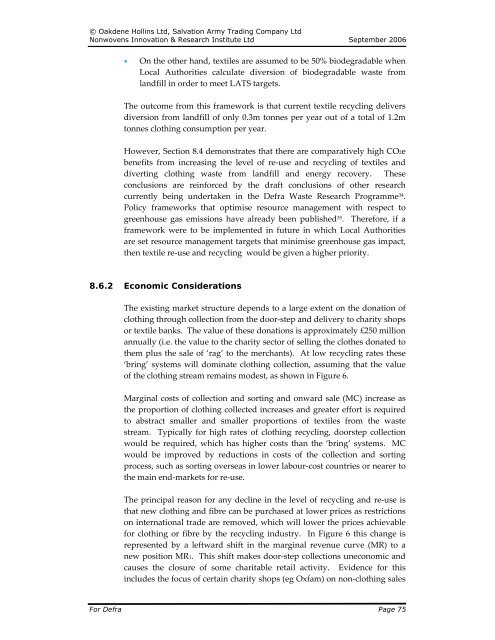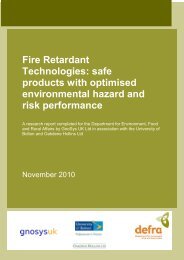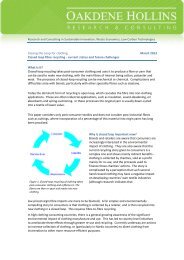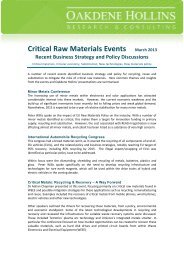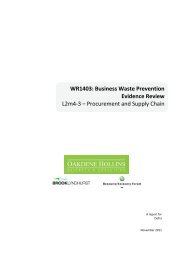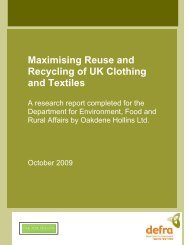Recycling of Low Grade Clothing Waste - Oakdene Hollins
Recycling of Low Grade Clothing Waste - Oakdene Hollins
Recycling of Low Grade Clothing Waste - Oakdene Hollins
Create successful ePaper yourself
Turn your PDF publications into a flip-book with our unique Google optimized e-Paper software.
© <strong>Oakdene</strong> <strong>Hollins</strong> Ltd, Salvation Army Trading Company Ltd<br />
Nonwovens Innovation & Research Institute Ltd September 2006<br />
• On the other hand, textiles are assumed to be 50% biodegradable when<br />
Local Authorities calculate diversion <strong>of</strong> biodegradable waste from<br />
landfill in order to meet LATS targets.<br />
The outcome from this framework is that current textile recycling delivers<br />
diversion from landfill <strong>of</strong> only 0.3m tonnes per year out <strong>of</strong> a total <strong>of</strong> 1.2m<br />
tonnes clothing consumption per year.<br />
However, Section 8.4 demonstrates that there are comparatively high CO2e<br />
benefits from increasing the level <strong>of</strong> re‐use and recycling <strong>of</strong> textiles and<br />
diverting clothing waste from landfill and energy recovery. These<br />
conclusions are reinforced by the draft conclusions <strong>of</strong> other research<br />
currently being undertaken in the Defra <strong>Waste</strong> Research Programme 34 .<br />
Policy frameworks that optimise resource management with respect to<br />
greenhouse gas emissions have already been published 35 . Therefore, if a<br />
framework were to be implemented in future in which Local Authorities<br />
are set resource management targets that minimise greenhouse gas impact,<br />
then textile re‐use and recycling would be given a higher priority.<br />
8.6.2 Economic Considerations<br />
The existing market structure depends to a large extent on the donation <strong>of</strong><br />
clothing through collection from the door‐step and delivery to charity shops<br />
or textile banks. The value <strong>of</strong> these donations is approximately £250 million<br />
annually (i.e. the value to the charity sector <strong>of</strong> selling the clothes donated to<br />
them plus the sale <strong>of</strong> ‘rag’ to the merchants). At low recycling rates these<br />
‘bring’ systems will dominate clothing collection, assuming that the value<br />
<strong>of</strong> the clothing stream remains modest, as shown in Figure 6.<br />
Marginal costs <strong>of</strong> collection and sorting and onward sale (MC) increase as<br />
the proportion <strong>of</strong> clothing collected increases and greater effort is required<br />
to abstract smaller and smaller proportions <strong>of</strong> textiles from the waste<br />
stream. Typically for high rates <strong>of</strong> clothing recycling, doorstep collection<br />
would be required, which has higher costs than the ‘bring’ systems. MC<br />
would be improved by reductions in costs <strong>of</strong> the collection and sorting<br />
process, such as sorting overseas in lower labour‐cost countries or nearer to<br />
the main end‐markets for re‐use.<br />
The principal reason for any decline in the level <strong>of</strong> recycling and re‐use is<br />
that new clothing and fibre can be purchased at lower prices as restrictions<br />
on international trade are removed, which will lower the prices achievable<br />
for clothing or fibre by the recycling industry. In Figure 6 this change is<br />
represented by a leftward shift in the marginal revenue curve (MR) to a<br />
new position MR1. This shift makes door‐step collections uneconomic and<br />
causes the closure <strong>of</strong> some charitable retail activity. Evidence for this<br />
includes the focus <strong>of</strong> certain charity shops (eg Oxfam) on non‐clothing sales<br />
For Defra Page 75


